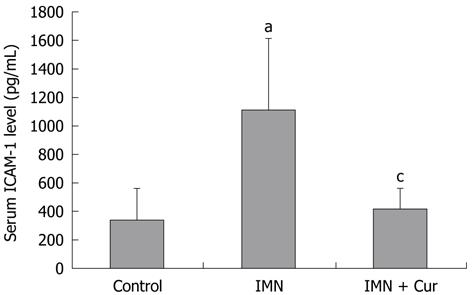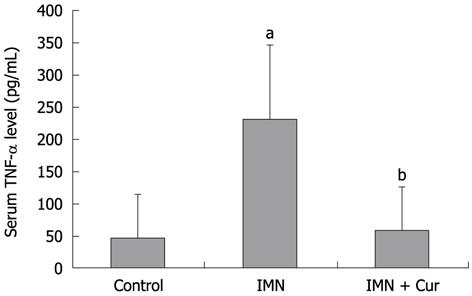Copyright
©2012 Baishideng Publishing Group Co.
World J Gastroenterol. Apr 7, 2012; 18(13): 1479-1484
Published online Apr 7, 2012. doi: 10.3748/wjg.v18.i13.1479
Published online Apr 7, 2012. doi: 10.3748/wjg.v18.i13.1479
Figure 1 Hematoxylin-eosin stained stomach sections (× 200).
A: The control group showed normal stomach histopathology; B: The indomethacin treated group showed gastric ulcer formation and infiltration of inflammatory cells; C: The curcumin treated group showed a reduced degree of gastric ulcer formation and inflammation.
Figure 2 Intravital microscopic (× 40) images of leukocyte adherence on vascular endothelium of postcapillary venules 10-15 min after acridine orange injection in the control group (A), IMN group (B), and IMN + Cur group (C).
IMN: Indomethacin.
Figure 3 Serum intercellular adhesion molecule-1 levels in all groups.
All data are expressed as mean ± SD. The mean intercellular adhesion molecule (ICAM)-1 levels were significantly higher in the indomethacin treated group (IMN) when compared with the control group (aP < 0.05). Pretreatment with curcumin significantly decreased ICAM-1 level when compared with indomethacin (cP < 0.05). IMN: Indomethacin.
Figure 4 Serum tumor necrosis factor-alpha level in all groups.
All data are expressed as mean ± SD. The mean of tumor necrosis factor (TNF)-α levels increased in the indomethacin treated group when compared with the control group (aP = 0.009). Pretreatment with curcumin decreased serum of TNF-α when compared with indomethacin alone (bP = 0.013). IMN: Indomethacin.
- Citation: Thong-Ngam D, Choochuai S, Patumraj S, Chayanupatkul M, Klaikeaw N. Curcumin prevents indomethacin-induced gastropathy in rats. World J Gastroenterol 2012; 18(13): 1479-1484
- URL: https://www.wjgnet.com/1007-9327/full/v18/i13/1479.htm
- DOI: https://dx.doi.org/10.3748/wjg.v18.i13.1479












